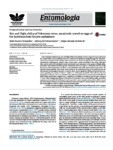Por favor, use este identificador para citar o enlazar este ítem:
http://www.alice.cnptia.embrapa.br/alice/handle/doc/1044783Registro completo de metadatos
| Campo DC | Valor | Lengua/Idioma |
|---|---|---|
| dc.contributor.author | POMARI-FERNANDES, A. | pt_BR |
| dc.contributor.author | BUENO, A. de F. | pt_BR |
| dc.contributor.author | BORTOLI, S. A. de | pt_BR |
| dc.date.accessioned | 2016-05-11T11:11:11Z | pt_BR |
| dc.date.available | 2016-05-11T11:11:11Z | pt_BR |
| dc.date.created | 2016-05-11 | pt_BR |
| dc.date.issued | 2016 | pt_BR |
| dc.identifier.citation | Revista Brasileira de Entomologia, v. 60, n. 2, p. 177-181, Apr./ Jun. 2016. | pt_BR |
| dc.identifier.issn | 1806-9665 | pt_BR |
| dc.identifier.uri | http://www.alice.cnptia.embrapa.br/alice/handle/doc/1044783 | pt_BR |
| dc.description | In two independent bioassays, size and flight ability of parasitoids reared on eggs of Corcyra cephalonica for 19 generations and parasitoids reared on a natural host (Spodoptera frugiperda eggs) for 250 generations were compared as fast quality control procedures for insect rearing. The size of parasitoids was examined by morphometric analysis using a stereoscope. Length and width of the wings, right hind tibia, and the body of 20 individuals (males and females) were measured. In the analysis of flight ability, parasitoids were divided into three groups: individuals able to fly ("flyers"), individuals that did not fly but had no visible deformation (?walkers?), and individuals with visible deformation ("deformed"). We observed that parasitoids were larger when reared on the natural host than on the factitious host for all evaluated morphological characters. However, there was no significant difference between the treatments regarding the number of "flyers", "walkers" or "deformed" parasitoids. This indicates that even though the rearing of T. remus on a factitious host affects parasitoid size, it does not necessarily affect its flight ability and therefore suggests that C. cephalonica is suitable as a factitious host for mass rearing of T. remus. Other biological parameters still need to be evaluated, such as host finding ability, parasitism capacity, and parasitoid field efficacy in order to provide a more complete picture of the effects caused by a host change. However, because fast laboratory tests are needed in rearing facilities, the one used in this study might be useful to rapidly assess parasitoid quality. | pt_BR |
| dc.language.iso | por | pt_BR |
| dc.rights | openAccess | pt_BR |
| dc.title | Size and flight ability of Telenomus remus parasitoids reared on eggs of the factitious host Corcyra cephalonica. | pt_BR |
| dc.type | Artigo de periódico | pt_BR |
| dc.date.updated | 2017-05-10T11:11:11Z | pt_BR |
| dc.subject.thesagro | Inimigo natural | pt_BR |
| dc.subject.thesagro | Criação massal | pt_BR |
| dc.subject.nalthesaurus | Natural enemies | pt_BR |
| dc.subject.nalthesaurus | Insect rearing | pt_BR |
| riaa.ainfo.id | 1044783 | pt_BR |
| riaa.ainfo.lastupdate | 2017-05-10 | pt_BR |
| dc.identifier.doi | 10.1016/j.rbe.2016.02.004 | pt_BR |
| dc.contributor.institution | ALINE POMARI-FERNANDES, Universidade Federal da Fronteira Sul; ADENEY DE FREITAS BUENO, CNPSO; SÉRGIO ANTONIO DE BORTOLI, UNESP Jaboticabal. | pt_BR |
| Aparece en las colecciones: | Artigo em periódico indexado (CNPSO)  | |
Ficheros en este ítem:
| Fichero | Descripción | Tamaño | Formato | |
|---|---|---|---|---|
| Sizeandflightability....pdf | 412,63 kB | Adobe PDF |  Visualizar/Abrir |









